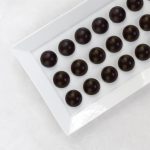Dark Chocolate
Have you ever wondered how to make chocolate at home? This recipe is for raw (= from unroasted cacao beans), tempered (= shiny, smooth, with a snap when you bite into it), dark (75%) chocolate. Watch the video above for more details!
Calories:
Ingredients
- 1 cup + 2 Tbsp. cacao butter , chopped
- 1 cup + 2 Tbsp. cacao powder
- 1/2 cup + 2 Tbsp. coconut sugar , powdered*
Instructions
- Set up a double boiler. Add a few inches of water to a medium saucepan and top it with a stainless-steel bowl that's slightly larger than the circumference of the saucepan. The bowl should create a seal with the bottom saucepan to trap the steam produced by the hot water. Ensure the bottom of the bowl isn't touching the water - this would cause the chocolate to get too hot. Bring the water to a gentle simmer over medium-low heat. Once the water is hot, turn the heat to the lowest setting. The water shouldn't be so hot that it produces vigorous steam or bubbles otherwise, the steam might get into the chocolate and cause it to seize.
- Melt the cacao butter with the cacao powder and coconut sugar. Add the cacao butter to the stainless steel bowl set over the saucepan, followed by the cacao powder and coconut sugar. Allow the cacao butter to melt slightly before stirring the cacao powder and coconut sugar in. If you start stirring right away, the whole mixture will just clump up and potentially burn.
- Heat the chocolate to 115°F/46°C. Warm up the chocolate, stirring constantly, until the temperature on the thermometer registers 115°F/46°C. If this is your first time tempering, consider taking the chocolate off the heat at 110°F/43.3°C and keep stirring until the temperature reaches 115°F/46°C. The residual heat of the bowl will warm up the chocolate slower than the steam. When taking the chocolate off the heat, be careful not to get any hot water/steam from the saucepan into the chocolate. Even a tiny bit of water will cause the chocolate to seize.
- Cool the chocolate to 81°F/27°C. Once the chocolate has reached 115°F/46°C, transfer it into a cool stainless steel bowl. Begin to stir the chocolate, using the full circumference of the bowl, until the temperature drops to 81°F/27°C. Stirring (aka agitating the chocolate) is necessary to properly distribute cacao butter beta crystals within the melted chocolate. Stirring will also help the chocolate cool faster.
- Reheat the chocolate to 88°F/31°C. Place the bowl with the cooled chocolate back over the saucepan with hot water (don't turn the stove back on) and warm the chocolate up, stirring constantly, until the temperature reaches 88°F/31°C. Monitor the temperature closely. If the chocolate overheats, you'll have to start the entire tempering process again.
- Test the tamper. Dip a piece of parchment paper into the chocolate. If the chocolate is correctly tempered, it will harden in 3-5 minutes. It will be shiny at the bottom and will release from the parchment paper easily. If it doesn't, repeat the tempering process.
- Use the chocolate while in temper. If you're making a chocolate bar or some other type of molded chocolate, pour the tempered chocolate into the mold as soon as it's in temper. Once the cavities are full, tap the mold briskly on the counter to settle the chocolate into any grooves or designs in the cavity and to force out air bubbles. Place the mold (cavity side up) on a flat cool surface to harden.
- Store. Tempered chocolate is best stored in a cool, ideally between 65-70°F/18.3-21.1°C, dry, dark place away from direct sunlight, moisture, and strong scents. If your house is warmer than 75°F/23.9°C, store the chocolate in an airtight container with as little air space as possible in the refrigerator. Always bring cold chocolate to room temperature before eating; cold chocolate doesn't melt or disperse flavor as nicely.
Notes
*Add the granulated coconut sugar to a high-speed blender (I use Vitamix) and blend on high until powdered. Note: using a high-speed blender to powder granulated coconut sugar will never yield as smooth results as using a mélanger (a granite stone grinder).
